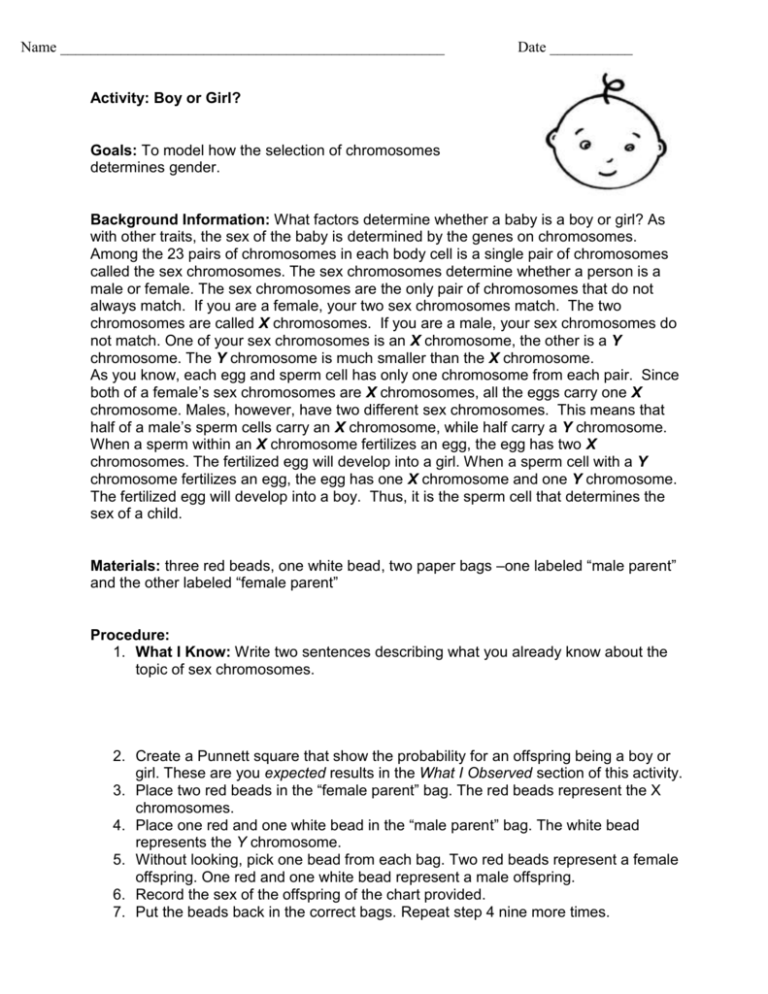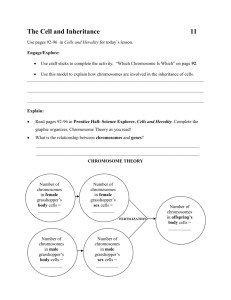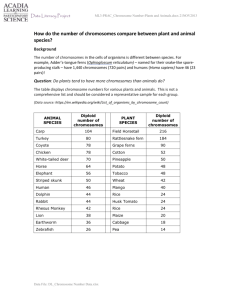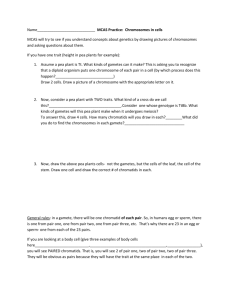Activity: Boy or Girl
advertisement

Name ___________________________________________________ Date ___________ Activity: Boy or Girl? Goals: To model how the selection of chromosomes determines gender. Background Information: What factors determine whether a baby is a boy or girl? As with other traits, the sex of the baby is determined by the genes on chromosomes. Among the 23 pairs of chromosomes in each body cell is a single pair of chromosomes called the sex chromosomes. The sex chromosomes determine whether a person is a male or female. The sex chromosomes are the only pair of chromosomes that do not always match. If you are a female, your two sex chromosomes match. The two chromosomes are called X chromosomes. If you are a male, your sex chromosomes do not match. One of your sex chromosomes is an X chromosome, the other is a Y chromosome. The Y chromosome is much smaller than the X chromosome. As you know, each egg and sperm cell has only one chromosome from each pair. Since both of a female’s sex chromosomes are X chromosomes, all the eggs carry one X chromosome. Males, however, have two different sex chromosomes. This means that half of a male’s sperm cells carry an X chromosome, while half carry a Y chromosome. When a sperm within an X chromosome fertilizes an egg, the egg has two X chromosomes. The fertilized egg will develop into a girl. When a sperm cell with a Y chromosome fertilizes an egg, the egg has one X chromosome and one Y chromosome. The fertilized egg will develop into a boy. Thus, it is the sperm cell that determines the sex of a child. Materials: three red beads, one white bead, two paper bags –one labeled “male parent” and the other labeled “female parent” Procedure: 1. What I Know: Write two sentences describing what you already know about the topic of sex chromosomes. 2. Create a Punnett square that show the probability for an offspring being a boy or girl. These are you expected results in the What I Observed section of this activity. 3. Place two red beads in the “female parent” bag. The red beads represent the X chromosomes. 4. Place one red and one white bead in the “male parent” bag. The white bead represents the Y chromosome. 5. Without looking, pick one bead from each bag. Two red beads represent a female offspring. One red and one white bead represent a male offspring. 6. Record the sex of the offspring of the chart provided. 7. Put the beads back in the correct bags. Repeat step 4 nine more times. 8. What I Observed: This section should include your Punnett square showing your expected results and the data table showing your observed results. A. Expected Results Create a Punnett square showing your expected results for the sex of an offspring. What percentage do you expect will be male? female? Punnett square: % of males: _______ % of females: _______ B. Observed Results Trial Sex chromosome selected from “female parent” bag Sex chromosome selected from “male parent” bag Sex of offspring 1 2 3 4 5 6 7 8 9 10 9. What I Wonder: Pose a question that arises from this activity or topic. 10. Questions: Answer the following questions in complete statements. a. How many males were produced? b. How many females were produced? c. How close were your observed results to the expected probabilities for male and female? 11. Claim and Evidence Writing Prompts: Use the following prompts to help you construct your lab conclusion, What I Learned. Goal: State the goal of this lesson. The goal of this lesson is… Claim: What did you learn from the activity that satisfies the goal of this lesson? This is an I Learned statement. I learned that… Evidence: How can you prove from your observations that you learned what you claim? This can be a general statement that you will explain in detail in your explanation. I know this because…. Explanation: Use specific data from your observations to support your claim and describe the evidence. Use details to support your claim. Concluding Statement: Reword the goal and either add information you learned about the topic from your text book, class discussions, and/ or personal research OR you can extend the statement by adding a relevant question. 12. What I Learned: Write at least a one paragraph summary of what you learned from completing this activity. Use the Claims and Evidence Writing Prompts to help you compose your summary.









